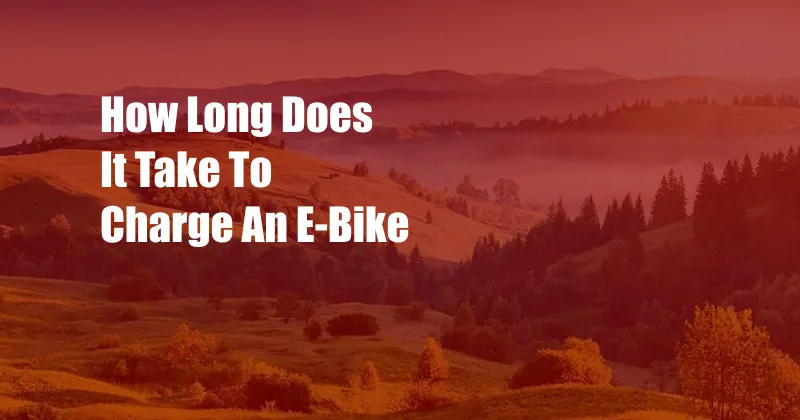
How Long Does It Take to Charge an E-Bike?
I vividly recall my first e-bike experience. The exhilarating surge of power as I pedaled effortlessly, leaving behind a trail of astonished faces. However, amidst the thrill, a lingering question gnawed at me: how long would it take to recharge this marvel of engineering?
My curiosity led me down a path of exploration, uncovering the intricacies of e-bike charging time. Join me as I delve into this topic, providing you with an in-depth understanding of the factors that influence charging time and empowering you to make informed decisions about your e-bike’s maintenance.
Factors Affecting E-Bike Charging Time
Battery Capacity
Battery capacity, measured in amp-hours (Ah), directly influences charging time. Larger batteries require more time to charge than smaller ones. For instance, a 500Wh battery will take longer to charge than a 250Wh battery.
Charger Power
The power of the charger, typically measured in watts, determines the rate at which the battery charges. Higher-powered chargers can reduce charging time significantly. For example, a 2A charger will charge slower than a 4A charger.
Battery Health
As batteries age, their ability to hold a charge diminishes. Consequently, older batteries will take longer to charge and may not reach their full capacity. Proper battery maintenance, such as avoiding extreme temperatures and over-discharging, can extend battery life and minimize charging time.
Environmental Conditions
Extreme temperatures can affect charging time. Cold temperatures can slow down the charging process, while warm temperatures can accelerate it. Therefore, it’s recommended to charge e-bikes in moderate temperature environments.
How Long Does It Take to Charge an E-Bike?
The charging time for an e-bike varies depending on the battery capacity, charger power, battery health, and environmental conditions. Generally, here’s an estimate of charging times:
- 250Wh battery: 2-4 hours
- 500Wh battery: 4-8 hours
- 750Wh battery: 6-12 hours
It’s important to note that these are approximate times. Actual charging time may vary slightly due to factors discussed above.
Tips for Faster E-Bike Charging
Here are some helpful tips to reduce e-bike charging time:
- Use a higher-powered charger: Invest in a higher-wattage charger to accelerate the charging process.
- Turn off the e-bike: Completely turn off the e-bike during charging to avoid any unnecessary power consumption.
- Charge in a temperate environment: Avoid charging in extreme temperatures, as they can affect charging efficiency.
By following these tips, you can optimize e-bike charging time and ensure your e-bike is ready for your next adventure.
FAQs on E-Bike Charging
- Q: Can I leave my e-bike plugged in overnight?
A: Yes, it’s generally safe to leave your e-bike plugged in overnight. However, it’s recommended to use a smart charger that automatically stops charging when the battery is full. - Q: Can I charge my e-bike on a regular outlet?
A: Yes, most e-bikes can be charged using a standard household outlet. However, verify the charger’s voltage and amperage requirements to ensure compatibility. - Q: How often should I charge my e-bike?
A: Charge your e-bike after every ride, or at least once a month if you don’t use it regularly. This prevents the battery from fully discharging and prolongs its lifespan.
Conclusion
Understanding e-bike charging time is crucial for maintaining the performance and longevity of your electric companion. By considering the factors discussed above and implementing the tips provided, you can optimize charging efficiency and ensure your e-bike is ready to power your next journey.
Are you intrigued by the world of e-bikes and eager to delve deeper into their charging mysteries? Let us know in the comments below, and we’ll be delighted to continue this exploration!